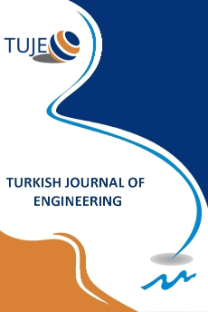pH CHANGE IN ELECTROCHEMICAL OXIDATION OF IMIDACLOPRID PESTICIDE USING BORON-DOPED DIAMOND ELECTRODES
pH CHANGE IN ELECTROCHEMICAL OXIDATION OF IMIDACLOPRID PESTICIDE USING BORON-DOPED DIAMOND ELECTRODES
In this study, pH and ΔpH change in the electrochemical oxidation of imidacloprid (IMD) pesticide using boron-doped diamond (BDD) electrodes was investigated in the presence of Na2SO4 electrolyte. The process parameters were operated as imidacloprid concentration (40-200 mg/L), electrolyte concentration (2-10 g/L), current density (4-20 mA/cm2) and reaction temperature (20-60°C). pH and ΔpH values increased with increasing Na2SO4 concentration, current density, and reaction temperature, and decreasing the imidacloprid concentration at 120 min reaction time. The results of this study showed that the pH of the wastewater solution maintained the local pH discharge limits between 6 and 9 after the electrochemical oxidation.
Keywords:
BDD, Boron-doped diamond electrode, Electrolysis, Imidacloprid Pesticide, Wastewater treatment,
___
- Arapoglou, D., Vlyssides, A., Israilides, C., Zorpas, A. and Karlis, P. (2003). “Detoxification of methyl-parathion pesticide in aqueous solutions by electrochemical oxidation”. Journal of Hazardous Materials, Vol. 98, No. 1-3, pp. 191-199.
- Brillas, E. and Martínez-Huitle, C.A. (2015). “Decontamination of wastewaters containing synthetic organic dyes by electrochemical methods. An updated review”. Applied Catalysis B: Environmental, Vol. 166-167, pp. 603-643.
- Brillas, E., Sirés, I., Arias, C., Cabot, P.L., Centellas, F., Rodríguez, R.M. and Garrido, J.A. (2005). “Mineralization of paracetamol in aqueous medium by anodic oxidation with a boron-doped diamond electrode”. Chemosphere, Vol. 58, No. 4, pp. 399-406.
- Cañizares, P., Sáez, C., Lobato, J. and Rodrigo, M.A. (2006). “Detoxification of synthetic industrial wastewaters using electrochemical oxidation with boron-doped diamond anodes”. Journal of Chemical Technology & Biotechnology, Vol. 81, No. 3, pp. 352-358.
- Cartaxo, M.A.M., Borges, C.M., Pereira, M.I.S. and Mendonça, M.H. (2015). “Electrochemical oxidation of paraquat in neutral medium”. Electrochimica Acta, Vol. 176, pp. 1010-1018.
- Comninellis, Ch. and Chen, G. (2010). Electrochemistry for the Environment, Springer, USA.
- Fontmorin, J.M., Fourcade, F., Geneste, F., Soutrel, I., Floner, D. and Amrane, A. (2015). “Direct electrochemical oxidation of a pesticide, 2,4-dichlorophenoxyacetic acid, at the surface of a graphite felt electrode: Biodegradability improvement”. Comptes Rendus Chimie, Vol. 18, No. 1, pp. 32-38.
- Galt, R.E. (2008). “Beyond the circle of poison: Significant shifts in the global pesticide complex, 1976-2008”. Global Environmental Change, Vol. 18, No. 4, pp. 786-799.
- Gullino, M.L. and Kuijpers, L.A.M. (1994). “Social and Political Implications of Managing Plant Diseases with Restricted Fungicides in Europe”. Annual Review of Phytopathology, Vol. 32, No. 1, pp. 559-581.
- Körbahti, B.K. and Artut, K. (2010). “Electrochemical oil/water demulsification and purification of bilge water using Pt/Ir electrodes”. Desalination, Vol. 258, No. 1-3, pp. 219-228.
- Körbahti, B.K. and Taşyürek, S. (2015). “Electrochemical oxidation of ampicillin antibiotic at boron-doped diamond electrodes and process optimization using response surface methodology”. Environmental Science and Pollution Research, Vol. 22, No. 5, pp. 3265-3278.
- Lazarević-Pašti, T.D., Bondžić, A.M., Pašti, I.A. and Vasić, V.M. (2012). “Indirect electrochemical oxidation of organophosphorous pesticides for efficient detection via acetylcholinesterase test”. Pesticide Biochemistry and Physiology, Vol. 104, No. 3, pp. 236-242.
- Madsen, H.T., Søgaard, E.G. and Muff, J. (2015). “Study of degradation intermediates formed during electrochemical oxidation of pesticide residue 2,6-dichlorobenzamide (BAM) in chloride medium at boron doped diamond (BDD) and platinum anodes”. Chemosphere, Vol. 120, pp. 756-763.
- Malpass, G.R.P., Miwa, D.W., Machado, S.A.S., Olivi, P. and Motheo, A.J. (2006). “Oxidation of the pesticide atrazine at DSA® electrodes”. Journal of Hazardous Materials, Vol. 137, No. 1, pp. 565-572.
- Palma-Goyes, R.E., Guzmán-Duque, F.L., Peñuela, G., González, I., Nava, J.L. and Torres-Palma, R.A. (2010). “Electrochemical degradation of crystal violet with BDD electrodes: Effect of electrochemical parameters and identification of organic by-products”. Chemosphere, Vol. 81, No. 1, pp. 26-32.
- Panizza, M. and Cerisola, G. (2009). “Direct and Mediated Anodic Oxidation of Organic Pollutants”. Chemical Reviews, Vol. 109, No. 12, pp. 6541-6569.
- Quiroz, M.A., Sánchez-Salas, J.L., Reyna, S., Bandala, E.R., Peralta-Hernández, J.M. and Martínez-Huitle, C.A. (2014). “Degradation of 1-hydroxy-2,4-dinitrobenzene from aqueous solutions by electrochemical oxidation: Role of anodic material”. Journal of Hazardous Materials, Vol. 268, pp. 6-13.
- Rajeshwar, K. and Ibanez, J.G. (1997). Environmental Electrochemistry, Academic Press, USA.
- Siné, G. and Comninellis, Ch. (2005). “Nafion®-assisted deposition of microemulsion-synthesized platinum nanoparticles on BDD”. Electrochimica Acta, Vol. 50, No. 11, pp. 2249-2254.
- Souza, F.L., Saéz, C., Lanza, M.R.V., Cañizares, P. and Rodrigo, M.A. (2016). “Removal of pesticide 2,4-D by conductive-diamond photoelectrochemical oxidation”. Applied Catalysis B: Environmental, Vol. 180, pp. 733-739.
- Steter, J.R., Kossuga, M.H. and Motheo, A.J. (2016). “Mechanistic proposal for the electrochemical and sonoelectrochemical oxidation of thiram on a boron-doped diamond anode”. Ultrasonics Sonochemistry, Vol. 28, pp. 21-30.
- Tarr, M.A. (2003). Chemical Degradation Methods for Wastes and Pollutants, CRC Press, USA.
- Urzúa, J., González-Vargas, C., Sepúlveda, F., Ureta-Zañartu, M.S. and Salazar, R. (2013). “Degradation of conazole fungicides in water by electrochemical oxidation”. Chemosphere, Vol. 93, No. 11, pp. 2774-2781.
- Vargas, R., Díaz, S., Viele, L., Núñez, O., Borrás, C., Mostany, J. and Scharifker, B.R. (2014). “Electrochemical oxidation of dichlorvos on SnO2-Sb2O5 electrodes”. Applied Catalysis B: Environmental, Vol. 144, pp. 107-111.
- ISSN: 2587-1366
- Yayın Aralığı: Yılda 4 Sayı
- Başlangıç: 2017
- Yayıncı: Mersin Uüniversitesi
Sayıdaki Diğer Makaleler
TREATMENT OF BIODIESEL WASTEWATER USING YELLOW MUSTARD SEEDS
Ömer UÇTU, İbrahim SEVİM, Bülent KARATAŞ, Burak ŞAHİN
Bahadır K. Körbahti, Mustafa Ceyhun Erdem
Berat Baris BULDUM, Suleyman Cinar CAGAN
CARBONATION RESISTANCE OF SLAG MORTARS ACTIVATED BY DIFFERENT ALKALI ACTIVATORS
